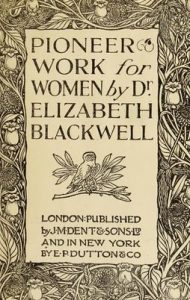Check out all our titles on spas!
Including…
Check out all our titles on spas!
Including…
Drop “Valentine” into the search box on the MHL’s Internet Archive page and you get some interesting results. Lots on nineteenth century physician Valentine Mott, as you might imagine, but also items about a blind child prodigy, Valentine Miller and a 1909 warning on the perils of venereal disease from the AMA.
You can also flip through F. C. Valentine’s 600 Medical Don’ts and, if you’re tired of reading, watch a compilation of Marlboro commercials!
The Biodiversity Heritage Library is an open access library for biodiversity literature and archives. The BHL currently has over 130,000 thousand volumes and you can learn more about the history of the BHL and the project partners here.
Library assistant Elizabeth Meyer has written a fascinating post about a title that the BHL and MHL share: John Forbes Royle’s 1837 volume, An essay on the antiquity of Hindoo medicine, including an introductory lecture to the course of materia medica and therapeutics, delivered at. King’s College.
You can see more of Royle’s writing in the MHL and see more from the BHL staff on their blog.
With Visits from the world of spirits…! (1791) #PageFrights may not be official this year but we’re keeping the spirit going.
We’re in the last stages of our state medical society journals project and you can see a full list broken down by state and date here. We’re still filling gaps, so the list is still in the process of being updated as our partners add in more journals. So check back regularly if the year you’re looking for isn’t there!
In honor of #NationalPoetryDay (which was yesterday), this collection of poetry from physician Mark Akenside (1721-1770) seemed appropriate for this Wednesday.
~This post is courtesy Melissa Grafe, John R. Bumstead Librarian for Medical History, Head of the Medical Historical Library.
Happy (belated) Valentine’s Day! We thought we would focus on love, marriage, and venereal disease, sampling the many books on these topics that you can find in the Medical Heritage Library. Continue reading
 This week, the Medical Heritage Library is celebrating the life of Elizabeth Blackwell (1821-1910), the first woman to receive a medical degree in the United States and the first woman on the UK Medical Register. Elizabeth, born February 3, 1821, in Bristol, England, was the third child of Hannah (Lane) Blackwell (1792–1870) and Samuel Blackwell (1790–1838)’s nine children. Elizabeth attended Geneva Medical College from 1847 to 1849, and in 1853, she established a small dispensary in New York City with her sister, Emily (the third woman to receive a medical degree in the United States), and Dr. Marie Zakrzewska (1829-1902); the dispensary expanded in 1857 to become the New York Infirmary for Indigent Women and Children. As an adjunct to the infirmary, Elizabeth and Emily founded the Women’s Medical College in New York in 1868. In the years following the Civil War, Elizabeth resettled in England. There, with physician and feminist Sophia Jex-Blake (1840-1912), she founded the London School of Medicine for Women in 1874. Like her sisters, Elizabeth Blackwell never married. Continue reading
This week, the Medical Heritage Library is celebrating the life of Elizabeth Blackwell (1821-1910), the first woman to receive a medical degree in the United States and the first woman on the UK Medical Register. Elizabeth, born February 3, 1821, in Bristol, England, was the third child of Hannah (Lane) Blackwell (1792–1870) and Samuel Blackwell (1790–1838)’s nine children. Elizabeth attended Geneva Medical College from 1847 to 1849, and in 1853, she established a small dispensary in New York City with her sister, Emily (the third woman to receive a medical degree in the United States), and Dr. Marie Zakrzewska (1829-1902); the dispensary expanded in 1857 to become the New York Infirmary for Indigent Women and Children. As an adjunct to the infirmary, Elizabeth and Emily founded the Women’s Medical College in New York in 1868. In the years following the Civil War, Elizabeth resettled in England. There, with physician and feminist Sophia Jex-Blake (1840-1912), she founded the London School of Medicine for Women in 1874. Like her sisters, Elizabeth Blackwell never married. Continue reading
The MC Migel Library of the American Printing House for the Blind has been adding lots of great new items recently. Here are just a few:
Additionally, the Wellcome Library has been adding lots of titles to its collection of medical officer of health reports all of which are available as part of the MHL, too.
On November 7, 1957, H. Rowan Gaither’s report, “Deterrence & Survival in the Nuclear Age” was issued. It called for $30 billion to build bomb shelters to protect American citizens in the event of nuclear war. In the years that followed, articles, such as those published in the New England Journal of Medicine (5/31/1962) called out the medical consequences of thermonuclear war, including “Some Psychiatric and Social Aspects of the Defense-Shelter Program” by P. Herbert Leiderman and Jack H. Mendelson. They bluntly summarized the situation: “It should be apparent that the psychologic and social problems raised in planning a defense-shelter program are of a magnitude and complexity that make it advisable to concentrate massive efforts on eliminating the need for such a program.” Data about the two atomic bombs dropped on Hiroshima and Nagasaki informed the discussion. Published in 1946, this “Medical report of the Joint Commission for the Investigation of the Effects of the Atomic Bomb” (volume 6) illustrates population and casualties, as well as building and shielding studies. Also check out Elena Carter’s “Beds not bombs: Highlights from the Medact collection.
~This post was originally on our Facebook page and is courtesy Emily R. Novak Gustainis.